Maybe you find yourself going back and forth on the right option to grow your business.
Perhaps you don’t know where to begin when faced with a choice or who on your team should be involved.
Do your team members often feel frustrated that they weren’t consulted on decisions impacting them?
If this sounds familiar, consider using the RAPID framework. This framework helps you to make decisions with input from others.
In this article, we will explore:
- A history of RAPID decision-making
- What RAPID stands for
- When to use RAPID decision-making
- The benefits of RAPID decision-making
- RAPID vs RACI
A history of RAPID decision-making
Bain & Company developed RAPID to clarify decision responsibilities and authority. The purpose is to define decision-making roles to allow organizations to make decisions more effectively.
Although the name is “RAPID,” the decisions aren’t meant to be rushed. Rather, the process intends to organize the process better so that decisions can be made more thoughtfully, by people in the right roles.
Decisions, or lack thereof, make businesses succeed or fail. In a highly competitive world, delaying decisions can cost your organization significantly, so yes, speed matters.
Today’s consumers don’t like to wait for new products or services they need. Let’s say two organizations manufacture cell phones. Many consumers want the latest and greatest technology as soon as it comes out. One of the companies is having disagreements about how they should implement new technology in their phones.
The second makes a quicker decision and gets their product out on the market. Customers will not wait for the first company to decide and implement their new phone technology. They will often rush to buy the product that is already available.
What does RAPID stand for?
Let’s take a look at what each letter in the RAPID acronym stands for. We’ll use an example of an accounting firm trying to deal with an increase in business after multiple large customers signed contracts with them.
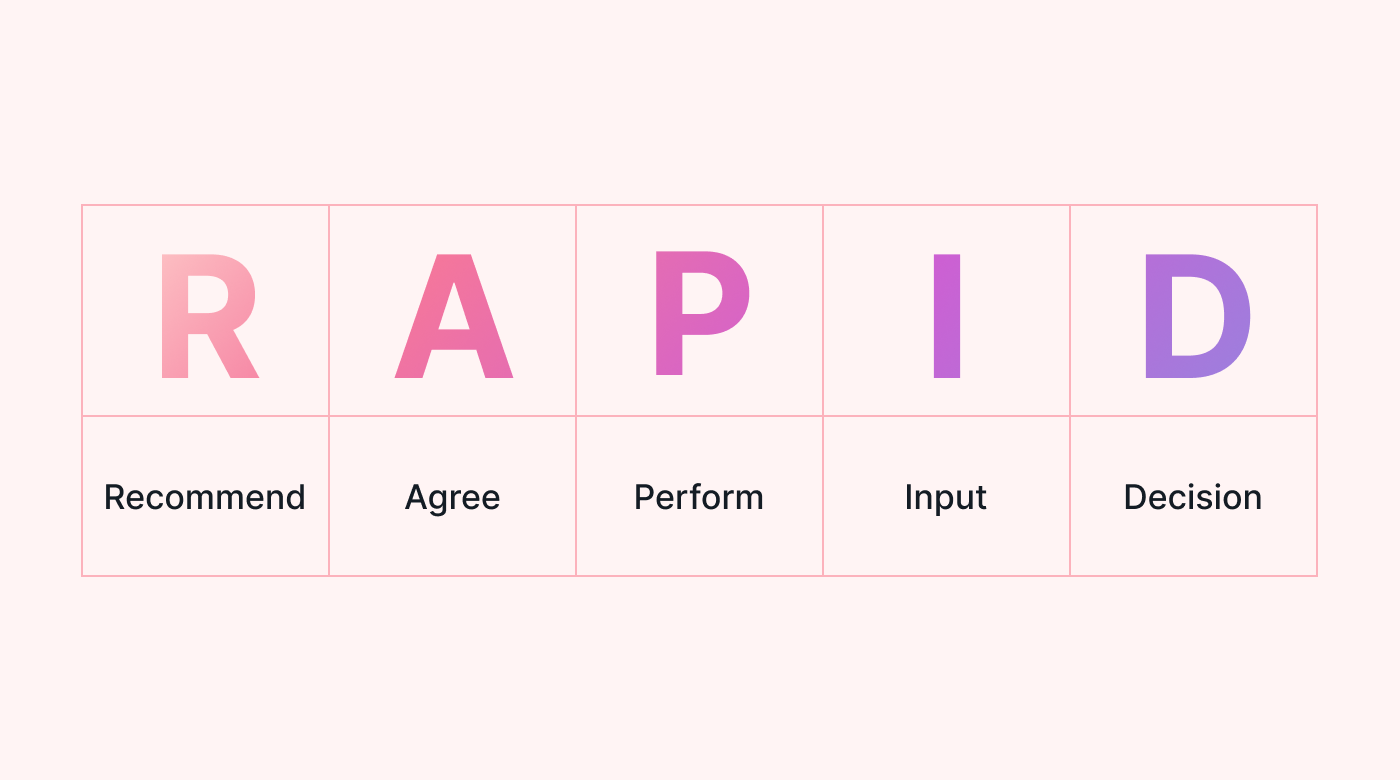 |
R: Recommend
The first step in our process is for someone to recommend a course of action.
The recommender should review data and analyze information to develop an initial recommendation.
In our example, the manager of our accounting team will be responsible for putting together a proposal of how to handle the extra work. Our accounting manager might be faced with deciding between hiring new team members and purchasing software to make the team more productive.
A: Agree
Although A is the second letter in RAPID, it’s the third step sequentially.
The agreer signs off on what the recommender suggests or helps them find an alternative solution.
In our example, the agreer might be a senior manager in the accounting department. In our example, the senior accounting manager might agree to hire more team members to keep up with the new and future growth, even though it would take time to get the team members up to speed.
P: Perform
Perform is the fifth and last action step completed in the RAPID process.
The performer is responsible for implementing the agreed-upon decision.
For example, if our final decision is to purchase new software to increase accounting productivity, the IT department would install the software on the accounting department’s computers and ensure the team members can start using it.
If we decide to hire more team members, our HR department and accounting manager will perform the hiring process.
I: Input
Input is second sequentially in RAPID.
The recommender gets input from stakeholders, team members who would perform the work, and others the decision would impact.
In this case, our accounting manager, the recommender, would get input from the business owner about how much of a budget the team has for implementing a solution and from HR and IT, who would perform the hiring or implementing work.
The accounting manager would also talk to the accounting team who does the actual work.
The accounting manager might ask questions about how much time they expect it would take to get new team members up to speed. Would the team have time to train new team members to be up to speed for the new client business? How long might training take for the new software? Does IT have enough capacity to take on installing the new software now? Does HR have time to take on hiring new candidates?
D: Decide
Decide is the fourth action that occurs in the RAPID process.
The decider makes the final decision, considering all information. The decision maker needs to have a good understanding of the business.
In our example, the director of the accounting department might have the final say and decide to hire more accountants.
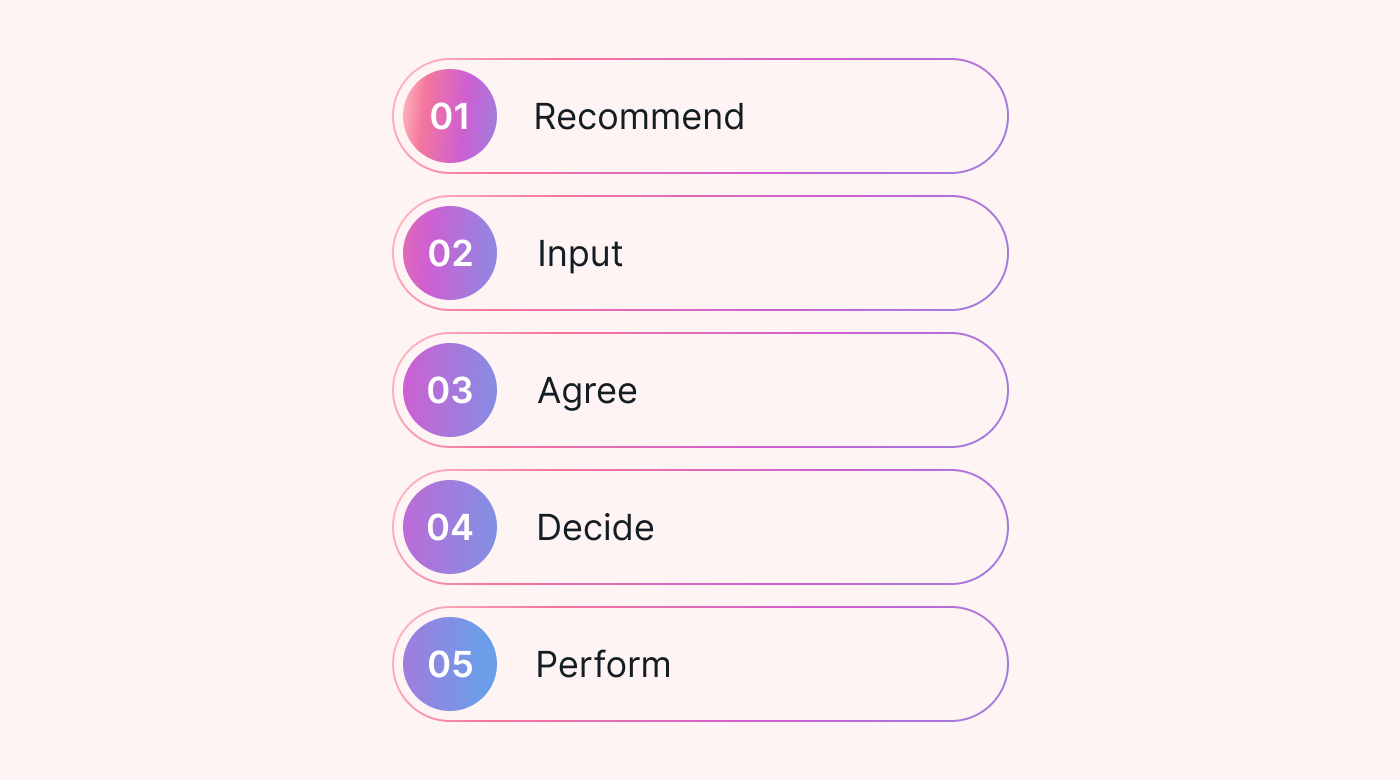 |
Here you can see that the order in which RAPID decisions are made and implemented is really R, I, A, D, P. Below is a model RAPID matrix using our example.
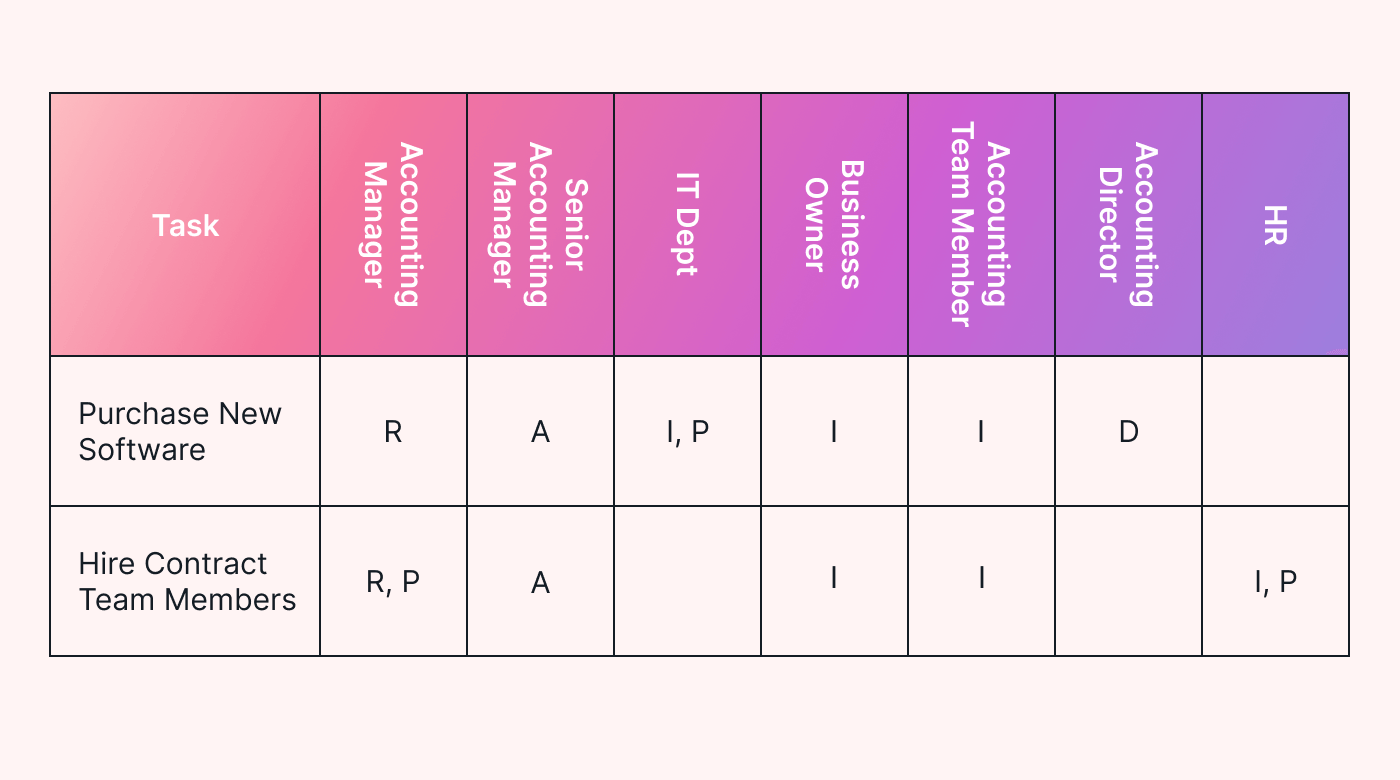 |
When to use RAPID decision-making
Decisions that one person can easily make without argument don’t need the RAPID framework for decision-making - for example, whether to approve a vacation request or not.
When multiple people think they should be deciding, RAPID pre-determines who will make which decisions and who will have other roles in the process. So when marketing and product development both think they will make feature decisions, or when divisional and regional management both think they will make pricing decisions, there’s no role confusion about who will make the decisions. The decision is faster when the correct people are involved.
For example, suppose a pancake house and an ice cream place begin a partnership to serve breakfast in the morning and ice cream later in the day to maximize the physical space use of their restaurants. In that case, both organizations will have opinions on working together. As the partnership begins, each organization may want to control how the marketing will occur. RAPID offers a way for them to work together.
Decisions that require input from multiple stakeholders are also good candidates for RAPID. For example, making decisions about new products to offer that involve a significant investment and a lot of work from the team would be a good candidate for a RAPID decision.
Complex decisions that require a lot of thought and analysis can benefit from RAPID. RAPID can speed up these types of decisions by having well-defined decision roles. Making reasonably quick decisions matters in a highly competitive world.
Decisions made in complex or conflicting situations, such as headquarters versus field offices or national versus local decisions in marketing, can also benefit from RAPID.
Benefits of RAPID decision-making
When your team defines RAPID roles, you will experience many benefits to your decision-making process.
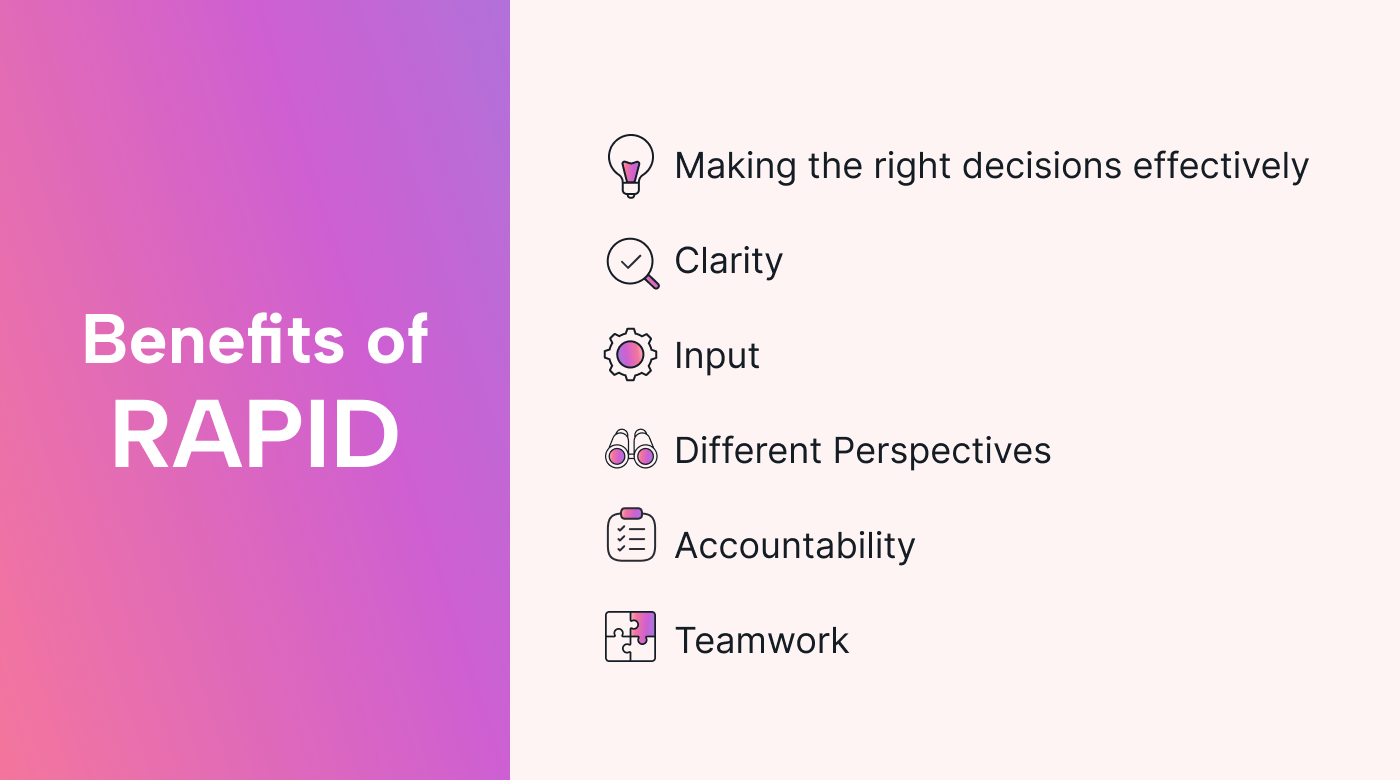 |
Making the right decisions and making them quickly
The biggest benefit of RAPID is making the right decisions and executing them more quickly in competitive situations.
RAPID clarifies who makes which kinds of decisions and who owns each role. It skips the step of figuring out who will decide what (and floundering around wasting time with that). Once roles are defined for decision types, the roles can be reused for all decisions of the same type.
Clarity on who is involved in the decision-making process
RAPID removes uncertainty over roles in the decisions. It becomes obvious who is involved and in what role.
Input from the right people
We’ve all shaken our heads at some point when a higher-up made a decision, and we wondered how on earth they thought that was a good idea. If they had asked someone who does the work, they could have been aware of potential issues or roadblocks before the decision got off the ground.
For example, if a sales team promises a customer a new software feature that isn’t possible with the company’s current technology, the customer will not be happy. If the sales team gets input from the IT department before making decisions about what the IT department will be working on, they will know what is and isn’t possible.
When you involve the right people in decisions, it leads to better decisions.
Different perspectives are included
Different team members and departments can give perspectives a decision-maker may not have considered. There are less likely to be significant issues overlooked when deciding based on the right input.
Accountability for decisions
When you document who is involved in RAPID decisions, it shows who is responsible for each part of the decision. People know whom to go to if they have questions about a decision or the process leading to it.
Teamwork and inclusion
People feel their input is valued when one person is not making decisions alone.
RAPID vs RACI
RACI is another role-defining decision-making process. Unlike RAPID, which is used for business decisions, RACI helps you define project roles. It is useful when assigning tasks or even major deliverables.
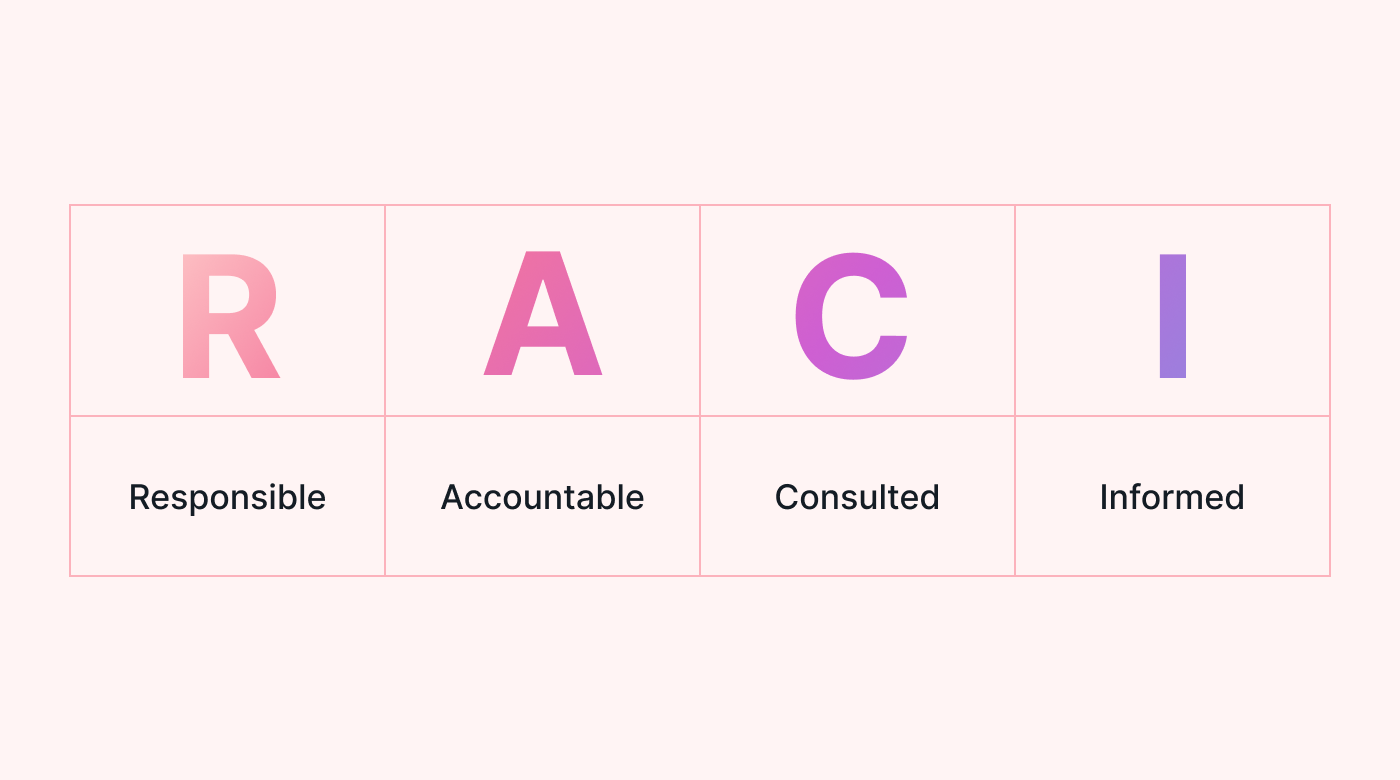 |
RACI is used to help create a plan for who will accomplish tasks. It focuses more on project deliverable details, while RAPID focuses on big-picture decisions.
Let’s take a look at the meaning of the RACI acronym.
R: Responsible
The responsible team member is whoever is performing the action.
A: Accountable
The accountable team member is responsible for the success or failure of an output or a project.
C: Consulted
The consulted team member provides input or feedback.
I: Informed
The informed team member receives updates on the process.
A RACI chart can show who has each role in the process. Let’s put together an example.
Let’s pretend we have a software development project to create a website for a bakery to accept cake orders.
Our team consists of a business analyst, developer, development manager, QA, QA manager, the director of IT, and our customer (the bakery).
The following tasks are required to complete our website:
- Write requirements
- Create test plan
- Develop the website
- Test the website
- Make bug fixes
- Release the website
While only one person writes the requirements (the business analyst), the developer and QA would use these requirements for their development and testing. It also would be helpful for them to get updates on the status of the requirements so they can plan when they will begin work on this project along with their other current projects. Will they be done tomorrow or in a week?
Programming would code the actual website, but it’s still helpful for QA to get updates on where it is so they can estimate when testing will begin.
When QA tests, they will send feedback to programming for bugs they find. Programming would get updates from QA.
QA and development management and the IT Director would like to ensure the project is on track and be informed of the status. The development manager may have input for the development process, and the QA manager may have input for the QA process.
The bakery will likely want to review requirements and know when the project is ready for release. They probably don’t need to get into the details of whether the project is in programming vs QA as long as the website is on time.
Our RACI would look like this.
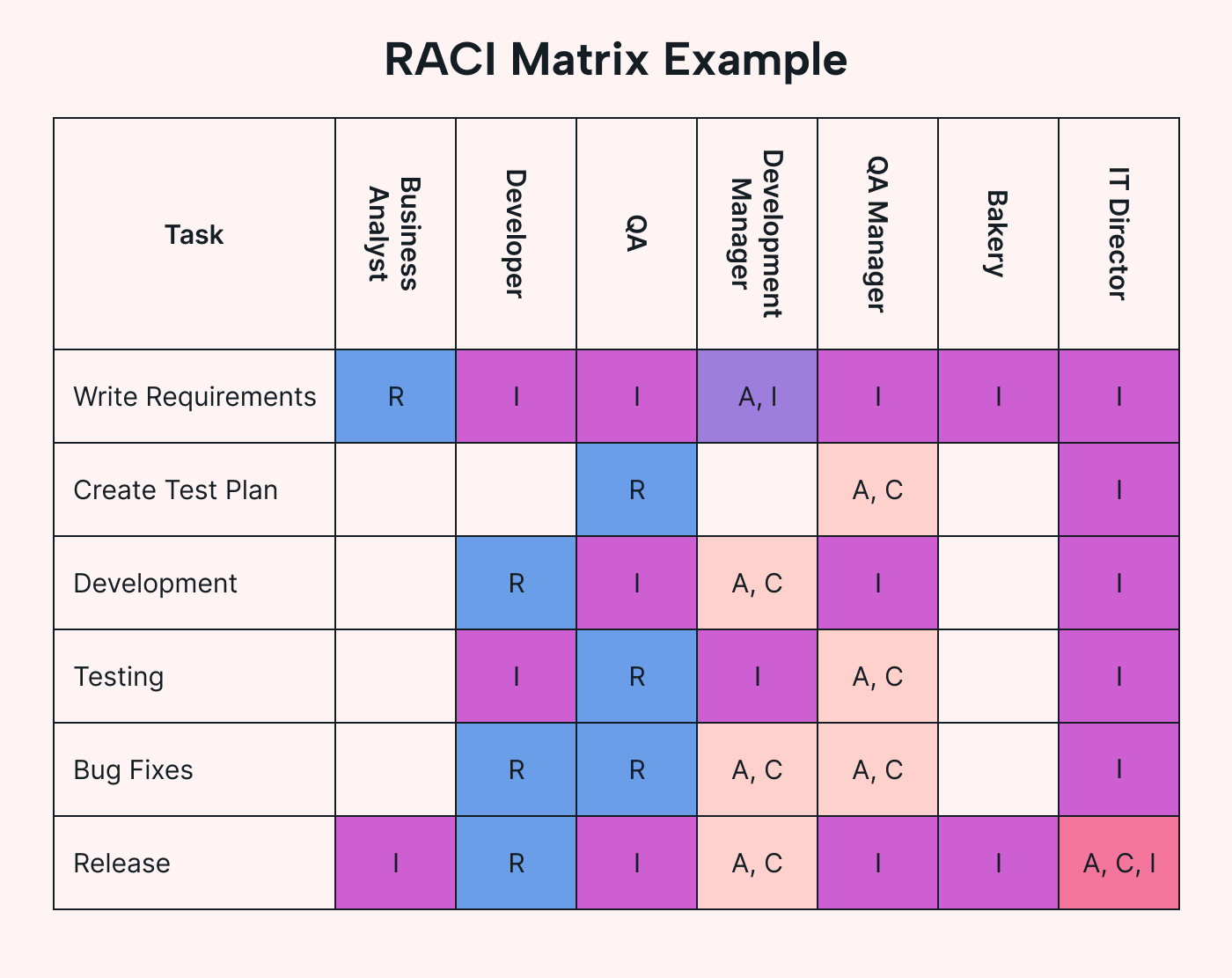 |
Use Motion to put decisions into action
Once your team is ready to implement a decision, consider using Motion to keep tasks on track.
Motion plans your schedule so you don’t have to think about what you will work on next - just like RAPID lays out decision-making steps for you so that you don’t have to think about what comes next in the decision-making process.
Enter tasks into Motion’s Task Manager. Motion’s Intelligent Calendar will put the tasks in the ideal spot among meetings and other tasks to ensure they will be completed on time. An alert is generated if a task will miss its deadline, so you can take action, such as reassigning a task to another team member.
If you’re not already using Motion, access a free trial today.





